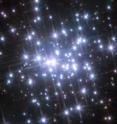Hubble catches stars on the move
Related images
(click to enlarge)
With a mass of more than 10 000 suns packed into a volume with a diameter of a mere three light-years, the massive young star cluster in the nebula NGC 3603 is one of the most compact stellar clusters in the Milky Way [1] and an ideal place to test theories for their formation. A team of astronomers from the Max-Planck Institute for Astronomy in Heidelberg and the University of Cologne led by Wolfgang Brandner (MPIA) wanted to track the movement of the cluster's many stars. Such a study could reveal whether the stars were in the process of drifting apart, or about to settle down.
The cluster, formally known as the NGC 3603 Young Cluster, is about 20 000 light-years from the Sun which makes these measurements extraordinarily difficult. It is necessary to compare images that were made years or even decades apart. The telescope and camera used must give very sharp images and be extremely stable over long periods.
Brandner and his colleagues realised that the Hubble Space Telescope was the best for the job. They found good data in the archives for the NGC 3603 cluster from a July 1997 observing run with the Wide Field Planetary Camera 2 (WFPC2), and then made their own follow-up observations in September 2007, using the same camera and the same set of filters as in the original observations. It then took the team two years of very careful analysis to extract reliable estimates for the motions of stars in the images.
Boyke Rochau (MPIA), the paper's lead author, who performed this analysis as part of his PhD work, explains: "Our measurements have a precision of 27 millionths of an arcsecond per year. This tiny angle corresponds to the apparent thickness of a human hair seen from a distance of 800 km."
In this laborious way, they were able to measure the precise speeds of more than 800 stars. About 50 were identified as foreground stars that are unrelated to the cluster, but more than 700 cluster stars of different masses and surface temperatures remained. The results for the motion of these cluster stars were surprising: this very massive star cluster has not yet settled down. Instead, the stars' velocities were independent of their mass and thus still reflect conditions from the time the cluster was formed, approximately one million years ago.
Stars are born when a gigantic cloud of gas and dust collapses. In cases such as the star forming region NGC 3603, where the cloud is unusually massive and compact, the process is particularly quick and intense. Most of the cloud's matter ends up concentrated inside hot young stars and the cluster keeps much of its initial gravitational attraction [2]. In the long term such massive compact star clusters may lead to the development of the huge balls of stars known as globular clusters, whose tightly packed stars remain held together by gravity for billions of years.
Wolfgang Brandner adds: "This is the first time we have been able to measure precise stellar motions in such a compact young star cluster." Team member Andrea Stolte from the University of Cologne adds: "This is key information for astronomers trying to understand how such clusters are formed, and how they evolve."
Source: ESA/Hubble Information Centre
Other sources
- Video: Hubble Glimpses Stars on the Movefrom PopSciWed, 2 Jun 2010, 21:22:01 UTC
- Hubble captures odd star motionfrom BBC News: Science & NatureWed, 2 Jun 2010, 18:25:04 UTC
- Hubble catches stars on the move: Surprising signs of unrest in massive star clusterfrom Science DailyWed, 2 Jun 2010, 16:31:56 UTC
- Hubble catches stars on the movefrom Science BlogWed, 2 Jun 2010, 15:02:58 UTC
- Hubble catches stars on the move (w/ Video)from PhysorgWed, 2 Jun 2010, 15:02:27 UTC
- Baby Steps of Stars Revealed by Hubble Telescopefrom Space.comWed, 2 Jun 2010, 14:32:32 UTC
